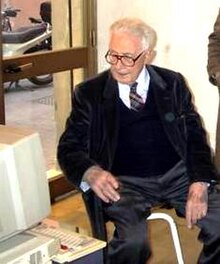|
Pietro Grossi
Pietro Grossi (15 April 1917, in Venice – 21 February 2002, in Florence) was an Italian composer pioneer of computer music, visual artist and hacker ahead of his time. He began experimenting with electronic techniques in Italy in the early sixties.[1] BiographyPietro Grossi was born in Venice, and he studied in Bologna eventually taking a diploma in composition and violoncello. In the sixties Grossi taught at the Florence Conservatory and began to research and experiment with electroacoustic music.[2] From 1936 to 1966 was the first cellist of the Maggio Musicale Fiorentino orchestra. Grossi began to experiment with electroacoustic music in the 1950s. By 1962, he had become the first Italian to carry out successful research in the field of computer music.[3] In 1963, he turned his interest to electronic music and founded the S 2F M (Studio di Fonologia Musicale di Firenze) which made its headquarters at the Florence Conservatory, and he also became a lecturer in this subject. In 1964 he organized events with the association Contemporary Musical Life that introduced in Italy the work of John Cage. In 1965 he obtained the institution of the first professorship of Electronic Music in Italy. In 1967 he made the first experiences in computer music.[4] In 1970 he made his first approaches to musical telematics organizing a performance with a link between Rimini (Pio Manzù Foundation) and Pisa (CNUCE). By invitation of lannis Xenakis, he presented another telematic concert between Pisa and Paris in 1974.  His contributions to the development of new technological musical instruments and to the creation of software packages for music-processing design have been fundamental with the original TAUmus/TAU2 station.[5] [6] He has not limited his work to the musical world, but also engaged in contemporary art. In the eighties he was working on new forms of artistic production oriented toward the use of personal computers in the visual arts. [7] Grossi started to develop visual elaborations created on a personal computer with programs provided with "self-decision making" and that works out the concept of HomeArt (1986), by way of the personal computer, raises the artistic aspirations and potential latent in each one of us to the highest level of autonomous decision making conceivable today, and the idea of personal artistic expression: "a piece is not only a work (of art), but also one of the many 'works' one can freely transform: everything is temporary, everything can change at any time, ideas are not personal anymore, they are open to every solution, everybody could use them".[8] Grossi has always been interested in every form of artistic expression. The last step of his HomeArt, is the creation of a series of unicum books, electronically produced and symbolically called HomeBooks (1991): each work is completely different from the others, thanks to the strong flexibility of the digital means. Sergio Maltagliati will continue this project creating autom@tedVisuaL software in 2012, which generates always different graphical variations. It is based on HomeArt’s BBC BASIC source code. This first release autom@tedVisuaL 1.0 has produced 45 graphical single samples, which have been sampled and published. He collaborated in order to experiment with electronic sound and composition with the computer music division of "CNUCE" (Institute of the National Research Council of Pisa).[9] Grossi’s latest multimedia experiments were with interactive sound and graphics. His later works involved automated and generative visual music software, autom@tedVisualMusiC 1.0 which he extended beyond the realms of music into the interactive work for the Internet, conceiving and collaborating with Sergio Maltagliati[10] in 1997 of the first Italian interactive work for the web netOper@,[11][12] entertaining in his own house study the first on-line performance. However, NeXtOper@ remains unfinished, a project to integrate new media, such as mobile phone and GPS.[13] Selected works
 Bibliography
Discography
DVD video
References
External links
|
||||||||||||||||||||||||
Portal di Ensiklopedia Dunia
